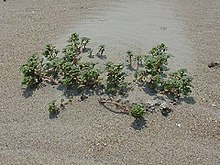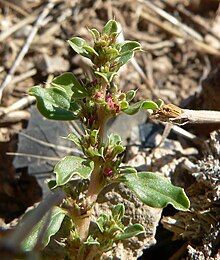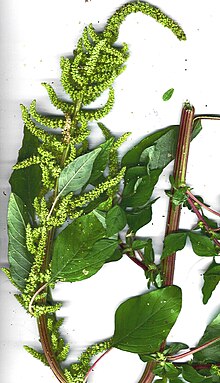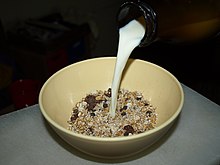Amaranth (plant genus)
| amaranth | ||||||||||||
|---|---|---|---|---|---|---|---|---|---|---|---|---|

Garden amaranth ( Amaranthus caudatus ) |
||||||||||||
| Systematics | ||||||||||||
|
||||||||||||
| Scientific name | ||||||||||||
| Amaranthus | ||||||||||||
| L. |
Amaranth ( Amaranthus ), also called foxtail , sometimes also written amaranth , is a genus of plants within the foxtail family (Amaranthaceae). The 60 to 98 species are distributed almost worldwide.
The fine-grained, millet- like seeds of the garden foxtail ( Amaranthus caudatus ), known in the Andean region to this day under the name Kiwicha , are mainly used . The Aztecs called him huautli . Contrary to the "real cereal species" it is not a question of monocots , but dicotyledonous plants.
description
Botanical characteristics
In Amaranthus TYPES There are usually annual , rarely perennial , herbaceous plants . The stems are mostly branched. The alternate leaves are arranged in a petiole and a leaf blade.
general characteristics
The inflorescences are usually very many-flowered. The flowers are always unisexual. The plants are either (in the subgenus Amaranthus and Albersia ) monoecious ( monoecious ) or dioeciously separated ( dioecious ) (in the subgenus Acnida ). In the female flowers can bloom missing, or there are a present to five and a stamp. The male flowers have three to five bracts and three to five stamens.
Occurrence
Worldwide occurrence
The genus Amaranthus includes 60 to 98 species that occur on all continents except Antarctica . Amaranthus species are common in the warmer zones of the earth , mostly in dry steppe areas , in wasteland and cultivated land. The greatest biodiversity is found in the New World ; there are around 38 species in North America alone.
European occurrence
At home in southern Europe , only Amaranthus graecizans L. and Amaranthus blitum subsp. oleraceus (L.) Costea .
Some Amaranthus styles are culture companion plants . Almost all species found in Europe have been introduced in the last two centuries, especially from the New World. The species found in Europe love warm and nutrient-rich soils . Since they need higher temperatures to germinate , they are mainly found in late-grown crops such as vegetables , maize , in vineyards and the like. Ä. With the expansion of maize cultivation to Central and Northern Europe , the amaranth species are also spreading as weeds .
The species found in Central Europe now include: white amaranth , white foxtail ( Amaranthus albus L. ), recumbent amaranth, western American foxtail ( Amaranthus blitoides S. Watson ), bouchon's amaranth ( Amaranthus bouchonii Thell. ), Curly amaranth ( Amaranthus crispus (Lesp . & Thév.) N.Terracc. ), Bent amaranth ( Amaranthus deflexus L. ), Greek amaranth ( Amaranthus graecizans L. ), spreading amaranth ( Amaranthus hybridus L. ), green-eared amaranth ( Amaranthus powellii S. Watson ), bent- back amaranth ( Amaranthus retroflexus L. ), Standley's amaranth ( Amaranthus standleyanus Covas ).





Systematics
The genus Amaranthus was set up in 1753 by Carl von Linné in Species Plantarum , 2, pp. 989-991. A homonym is Amaranthus Adans. , published in Michel Adanson : Familles des Plantes , 2, 1763, p. 269. The lectotype species is Amaranthus caudatus L .; it was in 1930 by Hitchcock and Green in Prop. Brit. Botanists , pp. 110-199. Synonyms for Amaranthus L. are: Acanthochiton Torr. , Acnida L. , Albersia Kunth , Amblogyna Raf. , Euxolus Raf. , Goerziella Urb. , Mengea Schauer , Montelia A. Gray , Sarratia Moquin-Tandon , Scleropus Schrader .
The genus Amaranthus is divided into three sub-genera:
- Subgenus Acnida (L.) Aellen ex KR Robertson
- Subgenus Albersia (Kunth) Grenier & Godron
- Subgenus Amaranthus
Types (selection alphabetically)
There are 60 to 98 Amaranthus species:
- Amaranthus acanthobracteatus Henr. : It occurs in Mexico.
- Amaranthus acanthochiton Sauer : It occurs in eastern Arizona, Utah, New Mexico, Texas and northern Mexico.
- Amaranthus × adulterinus Thell.
- White foxtail ( Amaranthus albus L. )
- Amaranthus anderssonii J.T. Howell
- Amaranthus arenicola I.M.Johnst. : It occurs in the central and northwestern United States.
- Amaranthus asplundii Thell. : It occurs in two varieties in Bolivia, Ecuador, Argentina and northern Chile.
- Amaranthus atropurpureus Roxb.
- Amaranthus aureus F.Dietr.
- Amaranthus australis (A.Gray) Sour : It is found in the southern United States, Mexico, the Caribbean, northern South America, and Brazil.
- Amaranthus bahiensis Mart.
- Amaranthus bigelowii Uline & WLBray
- West American amaranth , prostrate amaranth, West American foxtail ( Amaranthus blitoides S.Watson )
-
Ascending Foxtail ( Amaranthus blitum L. ): There are several subspecies and varieties:
- Rising amaranth, common earth amaranth ( Amaranthus blitum subsp. Blitum )
- Amaranthus blitum subsp. emarginatus (Moq. ex Uline & Bray) Carretero et al.
- Greenish amaranth, greenish pigweed ( Amaranthus blitum subsp. Oleraceus (L.) Costea )
- Amaranthus blitum var. Pseudogracilis (Thell.) Costea
- Amaranthus brandegeei Standl. : It occurs in the Mexican states of Sonora and Nayarit.
- Amaranthus brasiliensis Moq.
- Amaranthus brownii Christoph. & Caum : It occurs in Hawaii.
- Amaranthus × budensis Priszter
- Amaranthus californicus (Moq.) S. Watson : Found in western Canada, western and central United States, and northern Mexico.
- Amaranthus campestris Willd.
- Amaranthus cannabinus (L.) Sauer : It is found in the eastern United States.
- Amaranthus capensis Thell.
- Amaranthus caracasanus Kunth
- Amaranthus cardenasianus Hunz. : It occurs in Bolivia and Argentina.
- Amaranthus caturus Roxb.
- Garden Foxtail , Kiwicha, Inca Wheat ( Amaranthus caudatus L. )
- Amaranthus celosioides Kunth : It occurs in Colombia and Argentina.
- Amaranthus chihuahuensis S.Watson : It occurs in Mexico.
- Amaranthus clementii Domin
- Amaranthus cochleitepalus Domin
- Amaranthus commutatus A. Kern.
- Amaranthus congestus C.C. Towns.
- Amaranthus crassipes Schltdl. : It is native to the southern United States, Mexico, Colombia, Venezuela, and the Caribbean.
- Curled amaranth ( Amaranthus crispus (Lesp. & Thévenau) A.Terracc. ): It is native to Argentina.
- Panicle Foxtail ( Amaranthus cruentus L. )
- Amaranthus cuspidifolius Domin
- Bent-down amaranth ( Amaranthus deflexus L. ): Originally found in Peru, Argentina and possibly Bolivia.
- Amaranthus dinteri Schinz
- Amaranthus dubius Mart. ex Thell. : It is native to Mexico, Central America, the Caribbean, northern and western South America and Brazil. In tropical Africa and Asia, in Europe, Florida and in Fiji it is a neophyte.
- Amaranthus fimbriatus (Torr.) Benth. : It occurs in the southern United States and Mexico.
- Amaranthus floridanus (S.Watson) Sauer : It occurs in Florida.
- Amaranthus furcatus J.T. Howell
- Greek foxtail ( Amaranthus graecizans L. ): It is native to several subspecies in southern, central and eastern Europe, in Macaronesia, in Africa, on the Arabian Peninsula, in western and central Asia, in the Caucasus and on the Indian subcontinent in front.
- Amaranthus grandiflorus (JMBlack) JMBlack
- Amaranthus greggii S. Watson : It occurs in Louisiana, Texas and Mexico.
- Amaranthus haughtii Standl.
- Amaranthus hunzikeri N.Bayón
- Spread amaranth , spread foxtail, bastard amaranth, bastard foxtail, green-eared foxtail ( Amaranthus hybridus L. ): It is native to Canada, the USA, Mexico, Guatemala, Nicaragua, Costa Rica, Panama, the Caribbean, in the north and western South America and Brazil. It is a neophyte in the tropical, subtropical and warm-temperate zones of the earth.
- Mourning amaranth , green-eared foxtail, red foxtail ( Amaranthus hypochondriacus L. ): Its original home is probably North America.
- Amaranthus interruptus R.Br. : It occurs in Australia, New Guinea and Timor .
- Amaranthus kloosianus Hunz.
- Amaranthus leptostachyus Benth.
- Amaranthus lepturus S.F.Blake : It occurs in Mexico.
- Amaranthus lombardoi Hunz.
- Amaranthus looseri sweet.
- Amaranthus macrocarpus Benth. : It occurs in Australia.
- Amaranthus mangostanus L.
- Amaranthus minimus Standl.
- Amaranthus mitchellii Benth.
- Amaranthus muricatus (Gillies ex Moq.) Hieron. : It is native to Bolivia, Argentina, Paraguay, and Uruguay and is a neophyte in southeastern Australia, southwestern Europe, and the southeastern United States.
- Amaranthus × ozanonii Piszter
- Amaranthus pallidiflorus F. Muell.
- Amaranthus palmeri S. Watson : It is native to the United States and Mexico and is a neophyte in Spain, Sweden, Madeira, Cyprus, India and Australia.
- Amaranthus paolii Chiov.
- Amaranthus paraguayensis Parodi
- Amaranthus parvulus Peter
- Amaranthus persimilis Hunz.
- Amaranthus peruvianus (shower) Standl.
- Amaranthus polygamus L.
- Amaranthus polygonoides L .: It occurs in South Carolina, Florida, Texas, Mexico, Honduras, Belize and in the Caribbean.
- Amaranthus polystachyus Willd.
- Green-eared amaranth ( Amaranthus powellii S.Watson ): There are two subspecies.
- Amaranthus praetermissus Brenan
- Amaranthus pringlei S. Watson
- Coastal amaranth ( Amaranthus pumilus Raf. ): It is found in the eastern United States.
- Curved amaranth , field foxtail, arched foxtail, curved foxtail, curved foxtail, wire-haired amaranth, wire-haired foxtail, curved foxtail ( Amaranthus retroflexus L. ). Its home is North America, but it is almost worldwide a neophyte.
- Amaranthus rosengurttii Hunz.
- Amaranthus roxburghianus H.W.Kung : It occurs in India and China.
- Amaranthus scandens L. f.
- Amaranthus scariosus Benth. : It occurs in Mexico, Guatemala, Honduras, El Salvador, Nicaragua and Costa Rica.
- Amaranthus schinzianus Thell.
- Amaranthus scleranthoides (Andersson) Andersson
- Amaranthus scleropoides Uline & WLBray : It is found in Oklahoma, Texas and northern Mexico.
- Amaranthus × soproniensis Priszter & Kárpáti
- Amaranthus sparganicephalus Thell.
- Thorny foxtail , Malabar spinach ( Amaranthus spinosus L. ). Its home is probably the Neotropic, but it is a widespread neophyte in the tropical, subtropical and warm-temperate zones.
- Amaranthus squamulatus (Andersson) BLRob.
- Standley's Amaranth ( Amaranthus standleyanus Parodi ex Covas ): Its home is Argentina.
- Amaranthus tamariscinus Nutt.
- Amaranthus tamaulipensis Henrickson : It occurs in Texas and Mexico.
- Amaranthus tenuifolius Willd. : It occurs in Pakistan and northern India.
- Amaranthus × texensis Henrickson
- Amaranthus thelltianus Nevski . Also known as Amaranthus graecizans subsp. thelltianus (Nevski) Gusev put to Amaranthus graecizans .
- Amaranthus thunbergii Moq. : It is native to tropical and southern Africa and is a neophyte in Europe and Australia.
- Tricolored Foxtail , Chinese Salad, Vegetable Amaranth, Surinamese Foxtail ( Amaranthus tricolor L. )
- Amaranthus tuberculatus (Moq.) Sour : It is native to Canada and the United States.
- Amaranthus × tucsonensis Henrickson : It is native to Arizona and northern Mexico and is likely of hybrid origin.
- Amaranthus urceolatus Benth.
- Amaranthus venulosus S. Watson
- Green amaranth ( Amaranthus viridis L. ): It may be native to South America and is a widespread neophyte in the tropics.
- Amaranthus vulgatissimus Speg.
- Amaranthus watsonii Standl. : It occurs in southern California, southwest Arizona, and northern Mexico.
- Amaranthus wrightii S. Watson : It occurs in southern Colorado, New Mexico, Texas and Arizona.

history
Amaranth is one of the oldest useful plants known to man. It was already cultivated by the Coxcatlán culture in Tehuacán (Mexico) , and seeds have been found in graves almost 9,000 years old. For the Aztecs, Inca and Maya , the grain-like amaranth grains were a staple food alongside quinoa and corn .
Because of the religious importance of the amaranth, among other things as part of a communion-like ceremony in connection with a festival in honor of the Aztec god Huitzilopochtli (in which human blood was also used), the amaranth was grown in the 16th century by the Spanish under threat of Death penalty prohibited. After the ban was lifted, the benefits of the plant were almost completely forgotten for centuries.
Economically used species
Some species of amaranth are useful plants.
In the old world: ascending amaranth or ascending foxtail ( Amaranthus blitum L. ), vegetable amaranth ( Amaranthus tricolor L. ), green amaranth ( Amaranthus viridis L. )
In the new world: garden foxtail ( Amaranthus caudatus L. ), panicle foxtail ( Amaranthus cruentus L. ), mourning foxtail ( Amaranthus hypochondriacus L. ), thorny foxtail ( Amaranthus spinosus L. ), Amaranthus dubius Mart. ex Thell. (no German name known)

use
The seeds of the garden and panicle foxtail are used in a similar way to cereals . Botanically, however, amaranth is a pseudo- grain: it looks like grain and its seeds are used that way, but it does not belong to the group of sweet grasses . Amaranth is gluten-free . This makes it a wholesome and well-tolerated grain substitute for those with gluten intolerance ( celiac disease ). In addition, the high iron content is valuable in iron deficiency anemia and during pregnancy .
The leaves of all amaranth species are also eaten as a vegetable ; they have a distinct smell of spinach (if you grind them) and taste like very tender spinach or chard . The protein content of amaranth leaves even exceeds that of soy. The young inflorescences can also be used as vegetables. The seeds and flowers taste nutty, and when grown into seedlings, they are also edible. The taproot tastes sweet and like beetroot or beetroot. However, it is usually lignified and has to be rubbed, for example, in order to be able to use it.
The food industry uses amaranth today in baby and child food, as an admixture in bread , pastries and muesli , in pancakes and pasta , also in sausage products and in the fast food area for bars and snacks. There are also attempts to prepare beverages based on amaranth, including the brewing of gluten-free beer .
Amaranth develops its typical nutty smell when cooked. In preparation, amaranth should be washed out with the help of a hair sieve and warm water. It can be consumed in muesli, as a base in salads, in vegetable stir-fries or as a general side dish. Amaranth flour is only suitable for baking to a limited extent on its own; it should be mixed with flour containing gluten in a ratio of 1: 3 or 1: 2 , otherwise the gluten is missing. The natural food trade sells amaranth grains pure or as an ingredient (also populated ) in muesli mixes.
ingredients

Amaranth has a higher protein and mineral content than most traditionally grown grains around the world . The proteins consist to a large extent of essential amino acids , the content of calcium , magnesium , iron and zinc is very high, especially because of the high iron content, amaranth is particularly recommended for pregnant women. A relatively high proportion of carbohydrates are fiber . Amaranth contains a lot of unsaturated fatty acids . As a herbal product, amaranth is cholesterol-free.
The ingredients are combined in a ratio that is favorable for human nutrition.
However, amaranth contains certain tannins that can inhibit the absorption and digestion of vitamins, proteins and trace elements. Amaranth is also very rich in oxalic acid, which is why people who are prone to oxalate-containing kidney stones should refrain from excessive consumption.
etymology
The word "Amaranth" comes from the Greek [ἀμάραντος or Amarantos in Latin transcription]. It is composed of two parts of the word, the prefix (ἀ) a = un- and the verb (μαραίνω) maraino = to pass. This means something like "the one who does not perish / blooms forever". An amaranth plant was described by Dioscurides in his "Materia Medica". Also Pliny the Elder mentions (as Amaranthus) in his Naturalis Historia . The ancient names do not refer to the modern genus, of which at least one species, Amaranthus blitum , was known to ancient authors. The yellow flowering plant described by Dioscurides was probably the sand straw flower ( Helichrysum arenarium ). Pliny describes a red-flowered species ("spica purpurea"), probably silver firebrick ( Celosia argentea ) from the Amaranthaceae family. In both cases we are talking about plants, the color of which remains when dried. The name remained in use in antiquity and in the Middle Ages for an "everlasting" plant, which was ascribed magical properties and which could serve as a symbol for the Virgin Mary; it is not certain in all cases whether the literary uses of the name referred to a real plant at all or whether they were intended more mythically and symbolically.
Others
In the song "Amaranth" by the Finnish band Nightwish , this plant is used as a symbol of everlasting beauty and perfection. This symbolism was used several years earlier by the Swedish doom metal band Draconian . The title of the Enya album " Amarantine " is based on the name .
literature
- Fangxiu Xu, Mei Sun: Comparative analysis of phylogenetic relationships of grain amaranths and their wild relatives (Amaranthus) using ITS, amplified fragment length polymorphism, and double-primer fluorescent intersimple sequence repeat markers. In: Molecular Phylogenetics and Evolution. Volume 21, No. 3, 2001, pp. 372-387.
- Sergei L. Mosyakin, Kenneth R. Robertson: Amaranthus , p. 410 - online with the same text as the printed work , Flora of North America Editorial Committee (ed.): Flora of North America North of Mexico. Volume 4: Magnoliophyta: Caryophyllidae, part 1 , Oxford University Press, New York and Oxford, 2003, ISBN 0-19-517389-9 (description section).
- J. Marinelli: Stalking the Wild Amaranth: Gardening in the Age of Extinction. Henry Holt & Co., New York 1998, ISBN 0-8050-4415-9 (English, book about the search for the rare coastal amaranth).
- K. Pavlovic: Manufacture and characterization of fermented beverages from grain amaranth. Diploma thesis, University of Vienna, Vienna 2002.
- EJ Jäger (Ed.): Excursion flora from Germany. Vascular plants: Basic volume, 20th edition, Spektrum Akademischer Verlag, Heidelberg 2011, ISBN 978-3-8274-1606-3 .
Web links
- Identification key for the genus Amaranthus in Germany (Ulf Schmitz)
- Common names in many languages.
- Food lexicon .
Individual evidence
- ↑ data sheet at Blumeninschwaben.de .
- ↑ Thomas Miedaner, Friedrich Longin: Underestimated types of grain - Einkorn, Emmer, Dinkel & Co. Agrimedia, 2012, ISBN 978-3-86263-079-0 , p. 99 ff .
- ↑ First publication scanned at biodiversitylibrary.org .
- ↑ Amaranthus at Tropicos.org. Missouri Botanical Garden, St. Louis
- ↑ a b c d e f g h i j k l m n o p q r s t u v w x y z aa ab ac ad ae af ag ah ai aj ak al am an ao ap aq ar as at au av Amaranthus in the Germplasm Resources Information Network (GRIN), USDA , ARS , National Genetic Resources Program. National Germplasm Resources Laboratory, Beltsville, Maryland. (Update from June 9, 2011)
- ↑ Historia natural y moral de las Indias on cervantesvirtual.com.
- ↑ H. Vogelsang: Celiac Disease: The trend is rising. In: Journal of Nutritional Medicine. Volume 10 (3), 2008, pp. 12-15.
- ↑ a b c Johannes Vogel: Vegetable emergency food. Survival knowledge for extreme situations. peitsch Verlag, Stuttgart 2012, ISBN 978-3-613-50677-0 , pp. 84-86 & 117.
- ↑ Meret Bissegger: My wild plant kitchen . Identifying, collecting and cooking wild plants. AT Verlag, Aarau / Munich 2011, 2nd edition, ISBN 978-3-03800-552-0 , p. 91.
- ↑ Amaranth - one of the most important sources of protein for vegetarians In: Health magazine. 16 July 2015.
- ↑ Amaranth: Superfood, Pseudograin and Nutrient Suppliers In: The Huffington Post . October 12, 2015.
- ↑ Oxalic acid- containing foods on oxalsaeure.net.
- ↑ Mihai Costea & Francois J. Tardif: The name of the Amaranth: histories of meaning. In: Sida. 20 (3), 2003, pp. 1073-1083.









